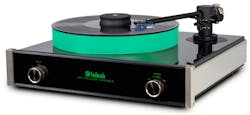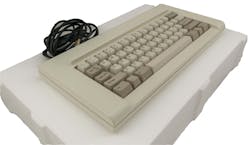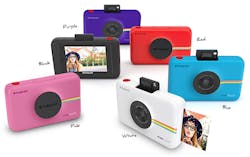Manufacturing Breathes New Life into Old Technology
The notion that today’s technology is “new and improved” may fall to the wayside and become replaced with another notion—“old and improved,” thanks to a resurgence in the manufacturing of old technology. It has been said that history tends to repeat itself and in some cases that can have a negative impact on future outlook. In the case of retro technology, we can give the Magic 8-Ball a shake and the reply would undoubtedly be “Outlook Good.”
Success is being found in “making it the old way.” One only needs to look at the resurgence of vinyl records to see how popular old tech has become. According to a 2017 Deloitte report, record manufacturers are set to generate $1 billion in revenue in 2017 alone, and the numbers show no indication of slowing down. Of course, the old/new medium still requires a turntable to listen to the analog sounds, and there are hundreds of different models on the market with new platforms seemingly being introduced every year.
You’d think there would be lawsuits aplenty for revamping the old tech in regards to patents. However, that’s easier to circumvent than one might think thanks to “Improvement patents.” In short, these protect the differences between a new product and previously existing products of the same kind, which can also be broken down into subsections, such as “additions” or “substitutions.” For example: An Addition invention could include adding an HD laser to an existing patented turntable design, while a Substitution invention could include “one-click” purchasing over using a “cart” for online shopping.
Suffice it to say, most companies and startups who are looking to reintroduce old tech with new improvements go this route, as it saves on headaches and legal paperwork. But make no mistake: It still costs money to do so, and could become a legal nightmare if done incorrectly. The age of Makers and the DIY crowd have also brought forth a surge in manufacturing capability previously unheard of 20 years ago, in that you can now outsource both locally and internationally using the least expensive bidder utilizing a host of online companies.
Joe Strandberg is one such maker/inventor who tapped into those easily accessible online manufacturing outlets. Strandberg’s love of the ancient Model F keyboard prompted him to build off IBM’s design, all the while retaining the luster of the popular ‘80s/’90s version.
His design is on par with IBM’s, meaning he modeled, molded, and used the same materials (mostly metal) and patent designs as close as he could rendition them to bring about his replica. He personally oversaw the build process using a Chinese manufacturer, including fabrication of the powder-coated zinc case and the buckling-spring keys the board is noted for.
Authentic Model F keyboards are difficult to find, as most no longer exist. The ones that do fetch a pretty penny, starting at a few hundred dollars. The major difference between IBM’s and Strandberg’s offerings are the number of customizations that can be had, including the number of keys and their placement, the color of the board, and even the serial number. As far as patent laws are concerned, IBM let the patents for the Model F expire, giving Joe free reign to use them as he saw fit with no legal ramifications.
Polaroid was widely known for its popular instant cameras that would churn out photos after the picture was taken. You would have to wait for several seconds for the photo to self-render, but it was worth it to view the images shortly afterward. Instant cameras faded away shortly after digital cameras hit the market, but these too are back with Polaroid’s latest offering: the Snap.
The Snap merges the digital age with the company’s classic instant dynamic. You can take a 10-megapixel full-color 2×3 image and save it internally, transfer it to PC, upload it to your social media platform of choice or print it out using Zink Holdings’ Zink Zero Ink Printing Technology (photo paper). The technology uses photo paper made from a composite material embedded with cyan, yellow, and magenta dye crystals. Printing the image is done by controlling a heat pulse, length, and intensity within the camera before it’s ejected.
Of course, manufacturing digital products for Polaroid isn’t an issue, as they already own the patents for the camera’s digital display and have partnered with Zinc Holdings for the crystal-based composite film.
Polaroid isn’t the only company that’s looking to capitalize on past popular technology, as Kodak has been touting the reemergence of its Super 8 Camera. Like the Snap, the Super 8 merges analog with digital in that it uses a digital camera to capture images on 8mm film.
Kodak designed the Super 8 as a traditional video recorder that looks similar to the original but has a flip-out video display to see what you’re filming. Images are transferred to an 8mm film cartridge you pop inside the camera while recording. Once done, you mail the cartridges in to Kodak, which transfers them to digital files that can then be downloaded from the company’s website.
The camera also comes equipped with an internal SD card for recording audio (using an internal mic), as well as an HDMI port you can use to see the action on larger displays. Kodak announced the new Super 8 at this year’s CES but has since been delayed due to Kodak wanting user input for additional features. Since Kodak already designs and manufactures their own video technology, they already own the patents as well as the Super 8 name, saving them from unnecessary headaches.
To that end, most of the larger companies that have produced popular technology in decades past don’t really have patent or manufacturing issues (unless they were taken illegally) due to having dealt with those previously, meaning they’ve already filed or paid for the patents and have no need to engage them for new products based on old designs. The same holds true for their manufacturing needs and constraints as most companies, including Polaroid and Kodak, either have their own plants or are contracted out with those that can handle manufacturing the technology.
On the other hand, smaller companies or individuals looking to manufacture new tech based on old technology will have to contract with their manufacturer of choice if they don’t have the capability to do so. Getting a license to an existing patent from another company can be a complicated endeavor and lead to legal ramifications. Regardless, it will cost money even if you choose to go with the Improvement patents mentioned earlier, which hasn’t stopped those looking to reintroduce the tech from yesteryear.
About the Author
Cabe Atwell
Engineer, Machinist, Maker, Writer. A graduate Electrical Engineer actively plying his expertise in the industry and at his company, Gunhead. When not designing/building, he creates a steady torrent of projects and content in the media world. Many of his projects and articles are online at element14 & SolidSmack, industry-focused work at EETimes & EDN, and offbeat articles at Make Magazine. Currently, you can find him hosting webinars and contributing to Penton’s Electronic Design and Machine Design.






